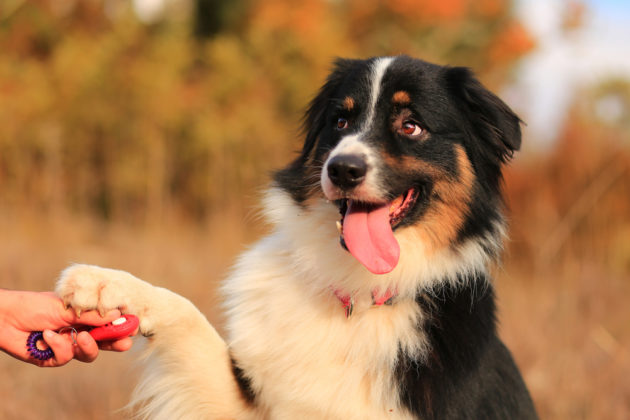Set your dog up for success with these suggestions for positive training.
Training simply means educating your dog in a safe and loving environment, and teaching her she can get whatever she wants through her actions, as long as she checks with you first. Training should begin the moment you first bring your dog home, whether she’s a seven-week-old puppy or a nine-year-old rescue.
1. Plan ahead
Collect everything you and your new dog will need, including highly valued treats, a bed, a proper collar, a six-foot nylon leash, tethers and a training clicker if you choose to use one. Create an environment that will promote success by puppy-proofing your house (remove inappropriate chewing objects like shoes, stuffed animals and the remote control), and appropriately using kennels, baby gates and exercise pens.
2. Make a behavioral wish list
Positive training isn’t about teaching your dog to stop doing something. It’s about teaching him what you want him to do instead. If you don’t know what you want him to do, he won’t be able to figure it out either, and both of you will end up barking at one another in frustration. For example, it isn’t about how you can get Buster to stop jumping; it’s about teaching him to lie down when people come through the door. It isn’t about getting him to stop chewing slippers; it’s about teaching him to chew appropriate toys and ignore slippers.
Make a wish list of likes (desired behaviors) and dislikes (unwanted behaviors). Then you can proactively teach your dog exactly what she is supposed to do rather than reactively try to correct unwanted behaviors.
3. Use consistent communication
We often inadvertently teach our dogs to do exactly what we don’t want them to do. For example, if you don’t want your dog to jump on you, don’t reinforce the jumping by occasionally petting him when he jumps. Be consistent and always have him sit or lie down before being petted.
A big problem people have is getting their dog to “stay”. This also has to do with inconsistent communication. For example, don’t say “stay” and then walk out the door without releasing your dog from the command. She’ll quickly learn that she can get up whenever she wants. You must give her a clear signal when you ask for a behavior — and another clear signal to complete it.
Mixed messages also often cause confusion and unreliable behavior. For instance, don’t say “sit down” if you mean “lie down”. Don’t say “down” if you mean “off”, as in “get off the furniture” or “get off me” when the dog jumps. Make sure every family member is using the same signals.
4. Maintain realistic expectations
Older or larger dogs can’t always do what younger or smaller ones can do – and vice versa (see sidebar). Train at your dog’s individual learning rate and also take her physical and emotional abilities into account.
5. Be positive and have fun
If it’s not fun for you, it’s not fun for your dog. Physical punishment and aversive training methods are not necessary and do nothing to promote or foster safety, patience, kindness and compassion. If you find yourself getting angry or frustrated, stop the training session and try again later. Positive training methods are far less stressful for you and your dog, since the attitude is that everything is a trick.
6. Train incrementally
Remember this line: “If your dog won’t do what you want him to do, go back to the step at which he was successful.”
There are basically three steps to every behavior:
- Get the behavior.
- Add the command (e.g. sit, down, come, etc.).
- Add the three “Ds” of distance, duration and distraction, in baby steps.
The big secret of successful dog training is that dogs are contextual. This means if you teach your dog to sit on the living room carpet, you have to start over again on the tile floor in the kitchen. If you teach a dog to sit while you are kneeling, you may have to start over again when you stand up. Each of these is a distinct context or situation and you have to teach your dog what you want when you change the scene. If you find yourself thinking, “My dog knows this, he’s just being stubborn,” think again. Have you actually taught your dog to stay with the vacuum cleaner running, or while you are standing ten feet away from her?
7. Keep sessions short
Training sessions can last from ten seconds to five minutes. That’s all you need. In fact, several two- or three-minute sessions a day are better than one or two lengthy ones. By keeping each session short, you can keep your dog highly motivated and anticipating the next one.
8. Reinforce spontaneous behaviors
Half of all your training will not be done in formal sessions. Instead, by practicing the “Magnet Game”, you can reward your dog whenever you catch her doing something you like. For example, whenever you see her sit or lie down, or pick up a toy, or look at the cat instead of chasing him, reward her. All these unasked for behaviors can act like “magnets” that attract praise, affection and treats. Your dog will quickly learn how to attract you and your rewards and will start sitting or lying down more and more often. Or she will start bringing you toys or looking at you instead of chasing the cat.
At first, give her the best treats you have when you catch her doing these behaviors. Gradually, praise and “life rewards” (getting to go for walks, chase a ball, get up on the couch, etc.) will replace the food, and the behaviors will eventually become established as rewards in and of themselves.
9. Give your dog a job to do
If you don’t give your dog a job, she will become self-employed by doing things you don’t want her to, such as digging up flowers, chewing shoes, barking excessively at people, etc.
Become your dog’s employer. Employment is important because it not only provides the stimulation your dog needs but it also promotes and develops a sense of self, purpose and pride. The objective of giving your dog a job is not to stop unwanted behaviors but to make you the boss. When you become his employer, you tell him when and where he should carry out a behavior…or not.
This means the “gardener” dog learns to dig in a sandbox, while the “home decorator” chews on toys instead of chair legs or cushions. The “alarm system” dog learns to bark three times when the mail carrier or visitor arrives, and then to lie down quietly.
10. Ask for help
Last but not least, ask for help if you can’t figure out how to train your dog, especially if you don’t know how to solve a particular problem. Aggression always calls for a professional positive trainer. Get referrals from your veterinarian, your friends, or from apdt.com. Interview each one and ask questions about the methods they use. Do they ever use choke chains or shock collars? Or pin dogs on their backs? This isn’t how you want your best friend treated.
Successful dog training is rooted in good old common sense, and in learning to anticipate problems before they happen. Train with love, affection and consistency and, above all, keep yourself and your dog safe.

